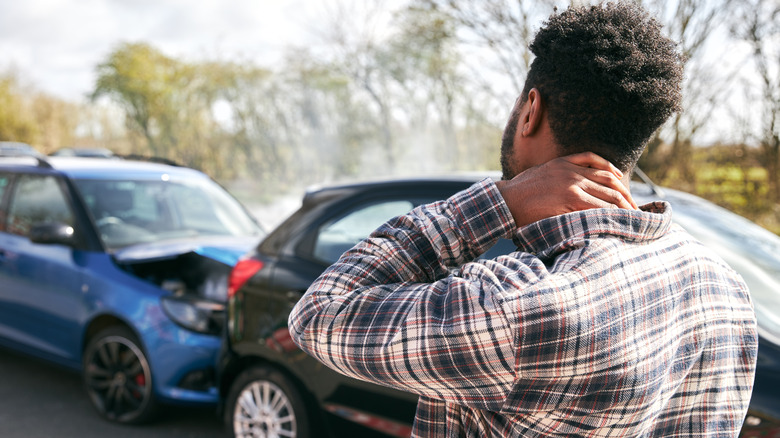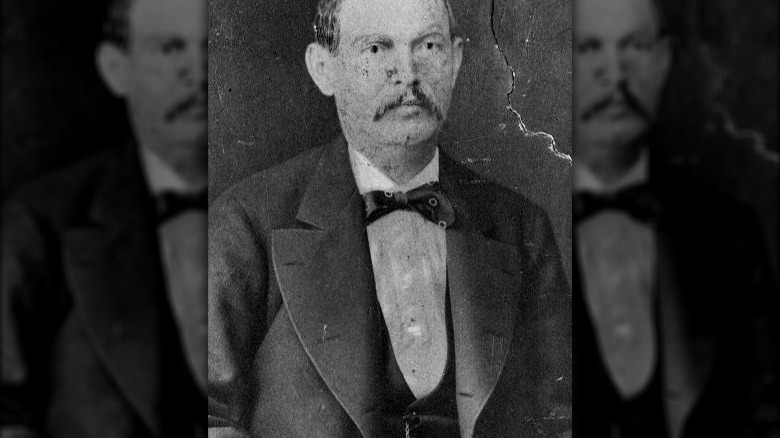The First Car Accident Victim In The United States
It's a little alarming to consider just how reliant so many of us have become on our cars. Until they break down at the most inopportune moment (not that there's ever an opportune moment), it's difficult to appreciate the fact that we often can't get to work without them, can't get to the grocery store without them, can't do the school run without them, and so on. After this realization, we generally have to pay a handsome premium to get them running again.
The United States is home to a particularly car-heavy society. According to Statista, the number of newly-registered vehicles in the country in 2020 was around 276 million. Per The World Factbook from the CIA, the nation's road system covers a remarkable total of 6,586,610 kilometers (around 4,100,000 miles) as of 2012.
This vast, vast network has a vital role to play in connecting a country of equally great scale. Tragically, though, such prolific road and highway use has resulted in countless accidents, many of which were fatal. Curiously, the first pedestrian to be killed in a car accident in the United States was struck by a very unusual vehicle.
Henry H. Bliss was struck by an electric cab in 1899
The World Health Organization stresses how terrifyingly common car accidents have become. On an annual basis, it reports, up to 50 million people around the world are injured in crashes, and a further 1.3 million are killed. Curiously, 73% of those killed are males less than 25 years old.
The first person to be killed in a road accident in the United States was a male, though one of more advanced years. The Mail (Adelaide, SA) of December 15, 1951 (via Trove) described the tragic Henry H. Bliss as a 68-year-old "Wall Street Broker with a snappy, drooping moustache." Bliss died on September 14, 1899, the day after his sad accident.
According to The Mail, he had been traveling to Harlem with his companion, named only as Miss Lee. The pair were exiting the tram at their destination, and as Bliss reached out to help Miss Lee get down, "there came roaring down the line, one of the 3,200 horseless carriages then in existence in the US."
The newspaper concluded that on being struck by the vehicle, Bliss lost consciousness, and passed away the next day without ever awakening.
The first such tragic fate of, sadly, so many
The offending vehicle was driven, Wired reports, by one Arthur Smith. It's very strange to think that, just before the turn of the twentieth century, Bliss was killed by an electric taxi, but that was exactly the designation of such carriages. According to the New York Times, via Times Machine, "two wheels of the cab passed over his head and body. His skull and chest were crushed." A doctor, David Orr Edson, had been riding in the cab, arranged an ambulance to Roosevelt Hospital and tried to help Bliss, the newspaper continued, but his injuries were so severe that nothing could be done for him.
Smith, Wired goes on, was charged with manslaughter as a result of the tragedy. The death was ultimately ruled an accident, and so Smith was not sentenced. According to The Mail (Adelaide, SA), via Trove, the hapless driver did not see Bliss until it was too late to change his course.
A century later, Atlas Obscura reports, a plaque was placed at the scene of the tragic event. Bliss' great-granddaughter attended the unveiling of the plaque, which was created by Citystreets. It serves as a memorial to the man who "became the first recorded motor vehicle fatality in the Western Hemisphere." It also reads that it was "erected to remember Mr. Bliss on the centennial of his untimely death and to promote safety on our streets and highways."


